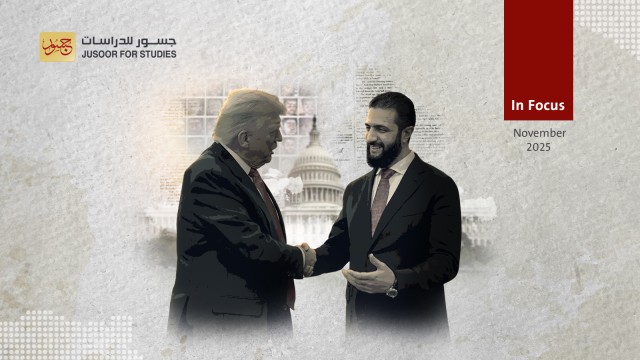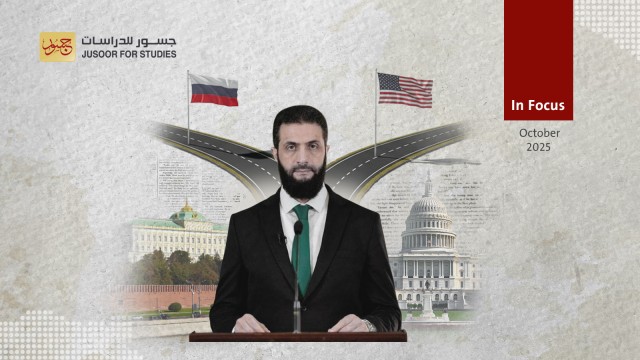Future Dynamics of Arab Tribal Clashes with the SDF in Deir ez-Zor
On September 8, 2023, the Syrian Democratic Forces (SDF) declared the completion of their main military operations in Deir ez-Zor. Following this, they transitioned to targeted security operations. This announcement indicates a strategic redeployment of their forces in areas they control in the Deir ez-Zor countryside. This move comes after a brief deployment of Arab tribal fighters in these territories at the start of the same month.
However, attacks carried out by the tribal fighters against the SDF in Deir ez-Zor continued. There were periods of escalation and de-escalation due to several internal and external factors. The region witnessed at least two major surges in violence. The first was on September 25th, during which tribal fighters launched attacks on multiple SDF checkpoints and positions across various areas in the northern and eastern countrysides of Deir ez-Zor. The second surge began on October 11th, following an audio message from the sheikh of the Al-Akidat tribe, Ibrahim Al-Hufl. This lasted for approximately two days, during which nearly 10 targets, ranging from vehicles to military checkpoints and barriers affiliated with the SDF, were simultaneously targeted in various areas of the eastern and northern countrysides of Deir ez-Zor.
Despite the Syrian Democratic Forces (SDF) announcing the end of their main military operations in Deir ez-Zor, targeted attacks by tribal fighters against them continued. The dynamics in the region have been characterized by intermittent periods of escalation and de-escalation, influenced by a mixture of internal and external factors. Two particularly notable escalations stand out; as the first took place on September 25th, when tribal fighters launched coordinated attacks on multiple SDF-held checkpoints and positions in the northern and eastern outskirts of Deir ez-Zor. A more intense surge of violence began on October 11th, instigated by an audio message from Sheikh Ibrahim Al-Hafel of the Al-Akidat tribe. Over the following two days, tribal militants systematically targeted nearly 10 SDF-associated sites, including vehicles, checkpoints, and military posts throughout the eastern and northern peripheries of Deir ez-Zor.
It has been observed that the majority of targeting operations were carried out simultaneously, even though they spanned several villages and towns. This synchronization suggests an evolved organizational capability among the fighters, who seem to predominantly operate in decentralized units. The strategy appears to be aimed at dispersing the security and military efforts of the SDF. However, despite this advancement in tactics, the fighters' armaments remain relatively basic, primarily limited to machine guns and RPG rockets. The core of their operations is predominantly focused in the areas where the Akidat tribe resides, especially in the eastern countryside locations like Al-Shuhail and the vicinity of the village of Dhiban. Notably, Dhiban serves as a significant hub for tribal fighters, as it is home to the leadership of the Akidat tribe. There are also occasional operations in the villages and towns of the northern countryside.
Generally, a set of internal and external factors can be identified that influence the reality and future of the operations of Arab tribal fighters against the SDF in Deir ez-Zor. Among the most prominent are:
- The capability to consistently secure the necessary financial, military, and logistical resources is vital for the tribal fighters' continued operations against the SDF. At present, this capacity largely hinges on acquiring light and medium weaponry from the black market, predominantly from areas under the control of the SDF or the regime situated on the opposite side of the Euphrates River. Sheikh Ibrahim Al-Hafel has repeatedly emphasized this in several audio messages, urging for financial support through donations to bolster the tribal fighters. This dependency presents a potential vulnerability that could be exploited by entities such as the Syrian regime or Iranian-backed militias. By providing these vital resources, these entities might aim to exert greater influence or even direct control over the tribal fighters' strategic decisions.
- The ability to expand the operational areas of the tribal fighters and to mobilize new tribes or clans to join the movement currently led by fighters from the Akidat is crucial. It appears that this is a primary focus of the current leadership, represented by Sheikh Ibrahim Al-Hafel.
- The SDF's consistent reliance on a security-driven and military-centric response towards the tribal unrest in Deir ez-Zor is palpable. Specifically, the SDF has firmly drawn a line against any possible concessions or withdrawal from the tribal side, given their official statement branding Sheikh Al-Hafl and his associates as criminals. This designation stems from their alleged role in attacks on SDF personnel in Deir ez-Zor. Inevitably, this posture fuels the ongoing resistance by tribal fighters against the SDF. Their aim remains either to realize their objectives or, at a minimum, to carve out new negotiation terms that would safeguard their leadership and members from future reprisals.
- The SDF's distractions with confrontations against other entities, be it local like the regime, or international such as ISIS or Turkey, can be an opportunity for tribal fighters. However, given the constraints in funding and weaponry faced by these fighters, they might opt to dial down their offensives against the SDF. Instead, they could capitalize on the external pressures the SDF faces from these third parties. This was particularly evident when there was a noticeable lull in the tribal fighters' activities during the week-long Turkish aerial campaign that targeted the SDF.
- The results of the U.S.-sponsored negotiations in Erbil are pivotal. Sheikh Musab Al-Hafel, Sheikh Ibrahim Al-Hafel's elder brother, champions the cause of the tribal fighters in these talks. However, it appears, at least for now, that this dialogue has hit snags, bearing no tangible outcomes. The SDF, and perhaps the coalition forces too, show a clear hesitancy to shift the governance structure in Deir ez-Zor areas, especially in the realms of security and military management. This stance by the SDF doesn't seem to be wavering, unless the tribal fighters exert substantial pressure, possibly pushing them to intensify their campaigns.
Essentially, the SDF's grip on Deir ez-Zor's outskirts remains tenuous due to tribal militants' activities and their inability to cement their chosen security-centric approach to quell the dissent. Simultaneously, the endurance and continuity of the tribal fighters in their skirmishes against the SDF are tied to key elements, especially procuring the needed human, financial, and military support. This appears to be the SDF's gamble as such resources, being self-contained and finite, risk running out without aid or backing from a regional or international entity. Hence, both sides seem to be playing a waiting game, eyeing the opportune moment amidst the coalition forces' somewhat neutral stance, keenly observing the on-the-ground dynamics and steering the dialogue between the factions.








